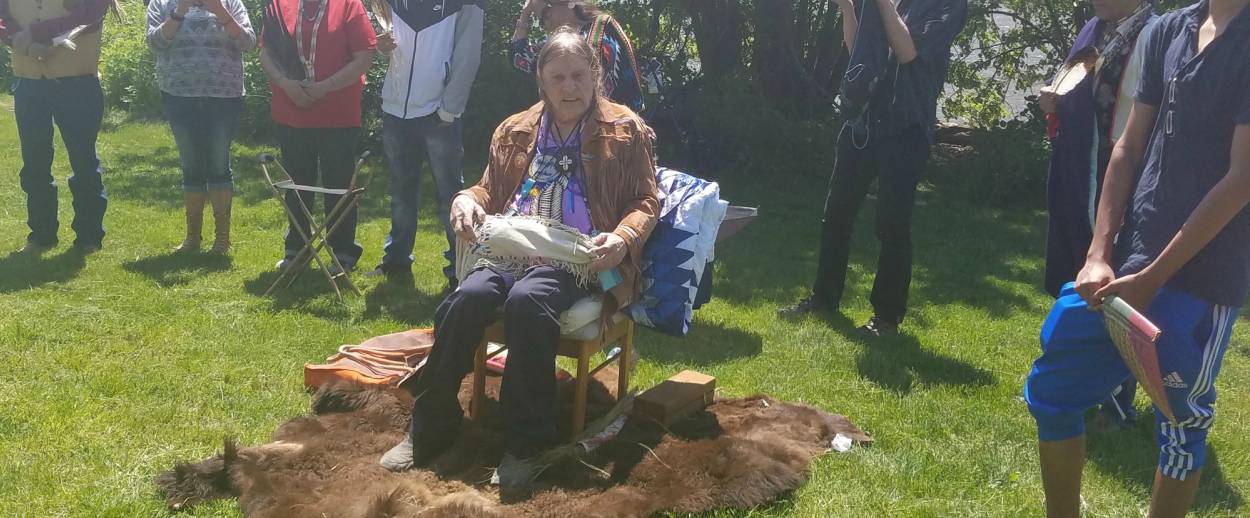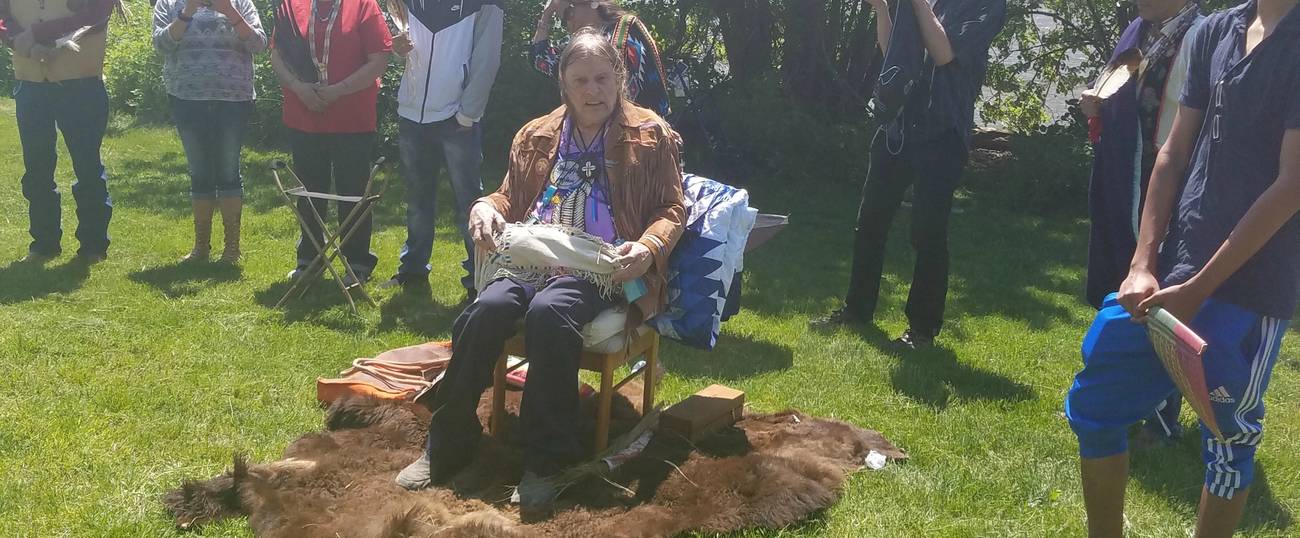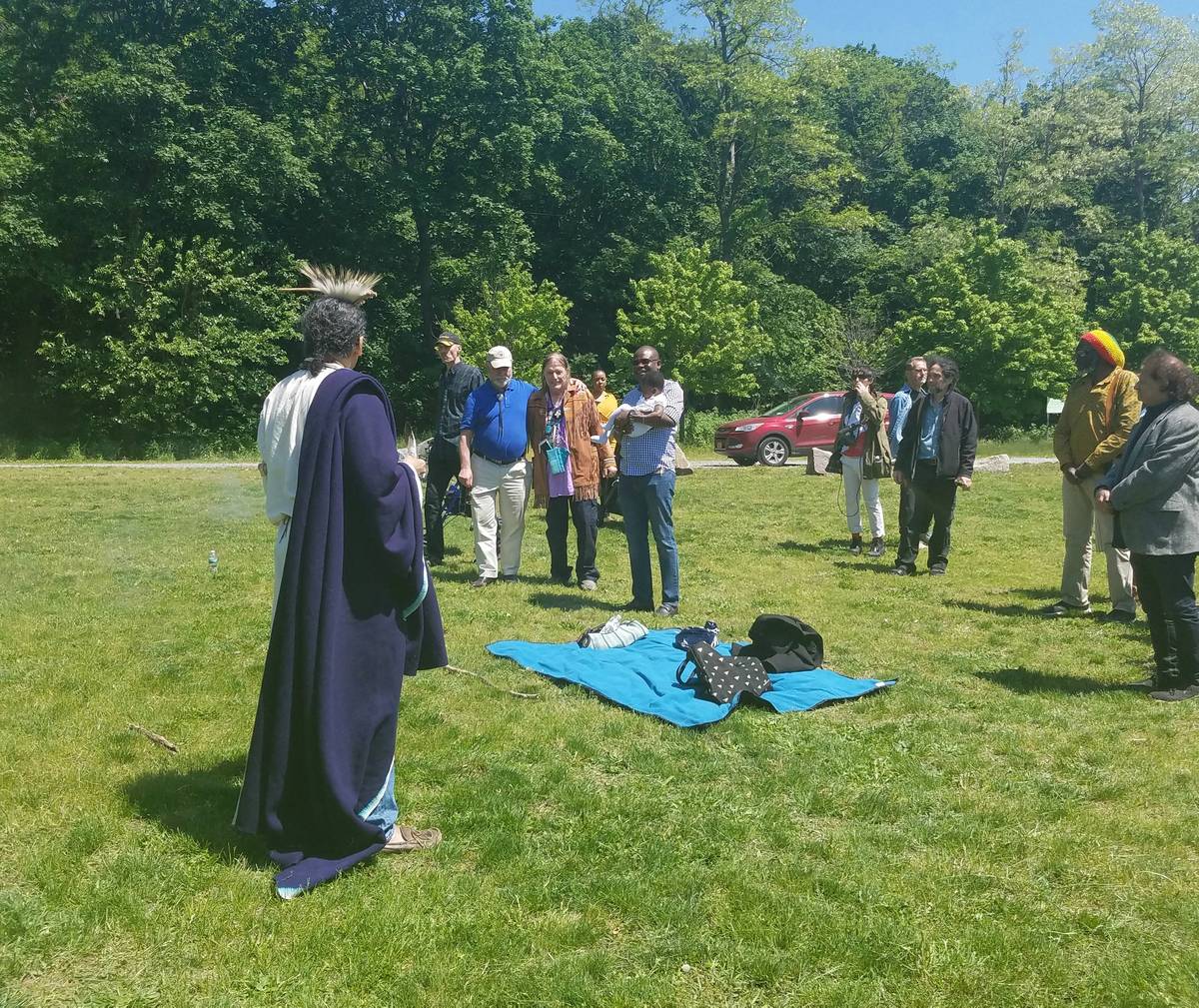On a breezy Sunday afternoon in late May in Foundry Dock Park on the Hudson River in Cold Spring, New York, Anthony Jay Van Dunk, a former chief of The Ramapough Lenape Nation, slowly walked clockwise, gingerly waving a burning sage stick. Clad in a tribal headdress, Van Dunk explained, “Smudging is a way of purification. It’s like washing your hands. It is done when you are preparing for ceremony.”
The Native American naming ceremony, led by Phyllis Young, a prominent Native American elder and member of Standing Rock Sioux Tribe, was held in honor of Jean-Louis Bourgeois, a 76-year-old wealthy activist in New York and the son of sculptor Louise Bourgeois who died in 2010 at the age of 98. His inheritance, from the proceeds of her artwork, finances his social justice activism. “This ceremony is our way of formally adopting him into our family,” said Young.
Last winter Jean Louis spent several weeks in Fort Yates, North Dakota, protesting an oil pipeline that would run through the Standing Rock Sioux Reservation. The Lakota Tribe believed the pipeline would jeopardize the water source of the reservation, the Missouri River. Bourgeois donated over $1 million in the campaign against “the black snake.”
“People came [to the Standing Rock protest camp] from all over the world and…we didn’t have the resources. It was winter, it was cold, we didn’t have enough blankets or tents,” said Young. “Jean Louis helped us in the most basic way possible, by providing food and shelter.”
An intimate group of about 50 of Bourgeois’s family and friends began trickling into the park in the afternoon. Guests included Chief Garry Rowland from Wounded Knee’s Pine Ridge reservation in South Dakota; Jenny Ghost Bear, a member of Standing Rock Sioux tribe; New York Times bestselling author Larry “Ratso” Sloman; Jim Drougas, proprietor of the Unoppressive, Non-Imperilist Bargain Book shop in Greenwich Village, where Bourgeois lives; and Richard Corey, the son of the late comedian Professor Irwin Corey.
“In indigenous ceremonies people sit with their clan, your family. However, we had a lot of people who didn’t know their clans,” said Van Dunk. “So I divided people up by direction. Each direction means something different: The East means rebirth. The sun travels from East to West, this is the path of life. The South is for people who are traveling, who are currently on their journey, The West is for those who are about to go on to their next life and the North is for observers.”
Bourgeois sat in the center.
“Walking into the prayer circle was a joyful moment,” said Bourgeois, who was wearing a brown, fringed suede jacket, a lavender shirt, and black trousers. A cluster of chunky, Native American bead necklaces hung from his neck. He clutched a labyrinth ring that was given to him by his late wife, the photographer Carolee Pelos. “I was so pleased that so many of my friends were there,” he said. “I was thinking of Carolee. I always think of her.”
In Native American culture a naming ceremony is a sacred event. Choosing a tribal name is a complex process influenced by an individual’s actions, personal characteristics and milestones. Jenny Ghost Bear of the Standing Rock Siouz tribe began the ceremony by singing a prayer song, summoning the spirits of the tribe’s grandfathers, grandmothers, and ancestors to the park.
“I chose the name Dream Keeper for Jean Louis because he kept our dream alive,” explained Young. “When he came to us we had struggled for generations on a wing and a prayer and we survived incredible odds. But this time there were so many people who came from all over the world that we had to provide food and shelter for and we didn’t have the resources to do that. He helped us in the most basic way possible by providing food and shelter. He kept our dream alive so that we could continue our struggle. He became a dream keeper.”
A stream of tears trickled down Bourgeois’s cheeks as Chief Rowlands braided two feathers into the honoree’s hair.
Jenny Ghost Bear sang a second prayer song, spiritually acknowledging Bourgeois’s new name.
Chief Rowlands filled the ceremonial pipe of the Lakota’s, a chanupa, with Top tobacco, lit it, and deeply inhaled. He passed it to Bourgeois who did the same. In Native American culture sharing the ceremonial pipe symbolizes the strengthening of a relationship.
“It was a very inspiring ceremony,” said Sloman. “For leaders of the Lakota tribe to come all the way to New York and recognize the amazing philanthropy of Jean Louis doesn’t happen everyday. The name ‘Dream Keeper’ was so apt. It was a tremendous recognition for the work Jean Louis’s done in shedding light on the plight of Native Americans.”
After the 30-minute ceremony guests retreated to Bourgeois’s nearby home, a sprawling townhouse with majestic views of the Hudson River in the shadow of Storm Point Mountain and West Point Military Academy. “I’m a river person,” Bourgeois commented. “It’s important for me to live near rivers.”
Guests dined on fry bread, wojapi (a sweet, thick, blueberry sauce), corn stew, pizza, hot dogs, and fruit salad while Young discussed how the Lakotas are steeped in tradition but also forward-thinkers. Alternative energy sources are on her radar. “We are currently working on an energy initiative with scientists,” she said. “They are doing a demonstration model that is based on our medicine wheel, it’s glass. You put the properties in the glass in the sun and it generates heat a hundred times faster than other utilities. “
After the meal guests received a special treat. “When we have a naming ceremony we honor those who attended with a small gift—it’s called a ‘giveaway,’” said Young, as she distributed Missouri River fleece blankets to guests. The Native American-inspired, brightly colored blankets had the names Buffalo Skull, White Buffalo End Of Trail, and Turtle designed on them.
“The naming ceremony was a tremendous honor for me,” said Bourgeois. “It marked a new chapter in my life. I feel born again.”


